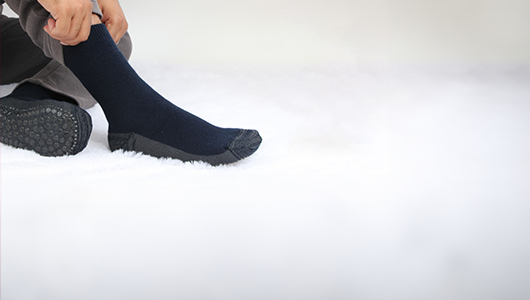
Best Men's Winter Socks: Keep Your Feet Warm and Cozy
When winter strikes, ensuring you're prepared with the right clothing is essential. One of the most overlooked winter essentials is quality winter socks. They’re crucial not only for comfort but also for overall foot health during the chilly months.
The Importance of 'Winter Socks for Men'
Winter brings a host of challenges, including maintaining warmth. While outerwear like jackets and gloves get most of the attention, the feet are often neglected. Proper winter socks are pivotal for several reasons:
-
Temperature Regulation: Our feet have a significant impact on regulating our body temperature. Cold feet can make the entire body feel cold.
-
Protection: Quality winter socks can prevent frostbite in extremely cold environments.
-
Comfort: Thick socks provide cushioning, making walking or standing more comfortable.

Why 'Bonjour Woolen Socks' Are the Talk of the Town
Among the plethora of brands available, 'bonjour woolen socks' stands out. But why is this brand preferred by many? Material Excellence: Bonjour socks are crafted with high-quality wool, ensuring warmth even in the coldest conditions.
-
Stylish Designs: Beyond function, their designs are fashionable, catering to a range of tastes.
-
Durability: These socks are made to last, resistant to wear and tear.
Materials Matter: 'Wool Socks Men' Prefer
The material of the sock determines its effectiveness in keeping feet warm. Wool, especially merino wool, has been the favorite for ages. Here’s why:
-
Insulation: Wool fibers trap air, creating an insulating layer between the foot and the cold outside.
-
Moisture Management: Wool can absorb a significant amount of moisture vapor, making them breathable.
-
Odor Resistance: Wool has natural antibacterial properties, reducing foot odor.
Exploring 'Winter Woolen Socks' Types
There are several types of woolen socks suited for various activities and temperatures:
-
Lightweight Wool Socks: Perfect for mild winters or indoor activities.
-
Midweight Wool Socks: Suitable for regular outdoor activities in cold conditions.
-
Heavyweight Wool Socks: Best for extreme cold conditions and prolonged outdoor activities.
Choosing the 'Mens Best Winter Socks'
When scouting for the best winter socks, consider:
-
Purpose: If you’re into winter sports, look for socks designed for that activity.
-
Fit: Ill-fitting socks can be uncomfortable and reduce circulation.
-
Length: Depending on personal preference and the type of shoe you wear, the length can play a part in your decision.

Care Tips for Longer-Lasting Socks
To ensure longevity:
-
Wash Inside Out: This prevents the outer layer from wearing out quickly.
-
Use Cold Water: Hot water can shrink the socks and weaken the fibers.
-
Air Dry: While it might take longer, air drying retains the sock's shape and structure better than machine drying.
Stats and Research on Winter Socks
A survey conducted by the Global Footwear Association highlighted that 75% of men prioritize warmth and comfort when choosing winter socks. Furthermore, woolen socks, particularly 'bonjour woolen socks', have seen a significant rise in sales in the past year, indicating their growing popularity.
Synthetic vs Natural: The Winter Sock Debate
There's an ongoing debate about the supremacy of natural fibers (like wool) compared to synthetic ones in winter socks. Here's a brief overview:
Natural Fibers (Wool):
-
Pros: Natural insulation, moisture-wicking, odor-resistant, biodegradable.
-
Cons: Can be pricier, might shrink if not properly cared for, potential for wool allergies.
Synthetic Fibers (Polyester, Acrylic):
-
Pros: Often cheaper, less care-intensive, durable, can be blended with other fibers for enhanced performance.
-
Cons: Less breathable than wool, might retain odors, not as environmentally friendly.
'Winter Socks for Men': The Impact of Thickness
The thickness of a sock can influence warmth but also the fit of the shoe. Here's a breakdown:
-
Ultra-thin socks: Ideal for dress shoes or tight-fitting footwear. They provide minimal insulation but maintain a sleek profile.
-
Medium-thick socks: These offer a balance between warmth and volume, making them suitable for regular winter boots and daily activities.
- Thick socks: Used for heavy-duty winter activities, they provide maximum insulation but require roomier footwear.
Sock Heights: From Ankle to Knee
The height of your winter socks can impact not just style but also warmth and protection:
-
Ankle-Length: Suitable for low-cut shoes and indoor wear. They're discreet but offer less warmth for the leg.
-
Crew-Length: These reach midway up the calf and are perfect for most outdoor activities.
-
Knee-Length: Offering maximum warmth, these are ideal for deep snow or cold activities where extra insulation is essential.
Ensuring Proper Circulation with ‘Winter Woolen Socks’
One might think that doubling up on socks or going for the thickest option is the best choice. However, ensuring proper blood circulation is crucial:
-
Avoid Too Tight: Socks that are excessively tight can restrict blood flow, leading to colder feet.
-
Layer Smartly: If layering socks, ensure the innermost layer is moisture-wicking to keep feet dry.
-
Stretch Periodically: When out in the cold for extended periods, stretch your toes and feet occasionally to promote blood flow.
The Environmental Footprint: Wool vs Synthetic
With growing awareness about sustainability, the environmental impact of our clothing choices is under scrutiny:
Conclusion:
Selecting the right winter socks is an amalgamation of understanding materials, knowing your needs, and being informed about what's available in the market. With options like 'bonjour woolen socks' available, men have the opportunity to merge style with functionality seamlessly. Don’t underestimate the power of a good pair of socks; they can truly make or break your winter experience.






